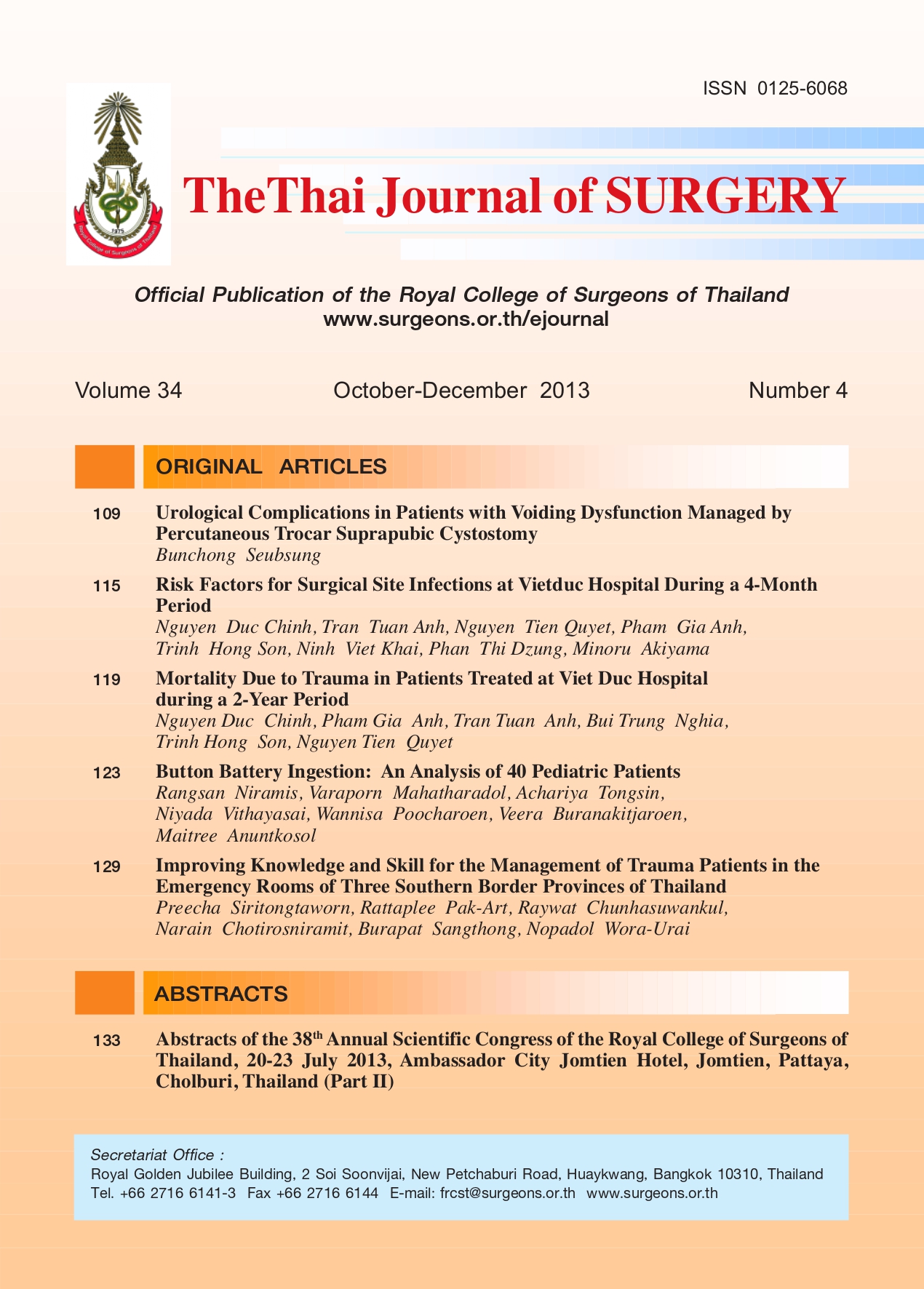Button Battery Ingestion: An Analysis of 40 Pediatric Patients
Keywords:
button/disc/disk battery ingestion, endoscopic removalAbstract
Objective: Button battery ingestion poses a special problem in children because of its potential for significantmorbidity and mortality. It may leak or burst within 24 hours of ingestion and cause corrosive alkaline burn or poisoning
from heavy metal salt. The aim of this study was to evaluate clinical characteristics, management and outcomes of
children with button battery ingestion over the last eight years at our institute.
Materials and Methods: Medical records of 40 patients who were admitted to Queen Sirikit National Institute
of Child Health due to button battery ingestion from January 2004 to December 2011 were reviewed. The diagnosis of
button battery ingestion was based on history, clinical symptoms, and results of radiological findings. Clinical data were
reviewed including demography, clinical manifestations, imaging findings, management, and outcome.
Results: Of the 40 patients, male to female ratio was 1.4:1. Approximately 50% of patients were under 2 years
of age (range, 8 months to 4 years). Only eight patients developed symptoms of dysphagia, vomiting or abdominal pain.
Thirty cases (75%) were brought to the hospital within six hours after button battery ingestion. One patient had a battery
impacted in the esophagus but spontaneously passed into the stomach. This button cell passed through the rectum three
days later. Twenty three cases had button batteries lodged in the stomach on admission. Sixteen cases underwent
gastroscopy with successful retrieval, whereas the remaining seven cases were conservatively treated. Button batteries
were lodged at the small and large intestine in 17 patients; these passed through the rectum successfully within two days.
There were no morbidity and mortality among these 40 patients.
Conclusions: Button battery ingestion is a common problem in children under five years of age. Batteries lodged
in the esophagus should be immediately treated by endoscopic removal. Treatment of button batteries lodged in the
stomach is controversial; either endoscopic removal or conservative management might be appropriate. Once the
button cells are found in the intestine, they will spontaneously pass through the rectum within two days in most cases.
References
/emedicinemedscape.com /article/774838-overview
(updated : Feb 7, 2011).
2. Litovitz T, Schmitz BF. Ingestion of cylindrical and button
batteries : an analysis of 2382 cases. Pediatrics 1992;89:747-
57.
3. Cheng W, Tam PKH. Foreign-body ingestion in children :
experience with 1,265 cases. J Pediatr Surg 1999;34:1472-6.
4. Chang YJ, Chao HC, Kong MS, Lai MW. Clinical analysis of
disc battery in children. Chang Gung Med J 2004;27:673-6.
5. Votteler TP, Nash JC, Rutledge JC. The hazard of ingested
alkaline disk batteries in children. JAMA 1983;249:2504-6.
6. Samad L, Ali M, Ramzi H. Button battery ingestion : hazards
of esophageal impaction. J Pediatr Surg 1999;34:1527-31.
7. Alkan M, Buyukyavuz I, Dogru D, Yalcin E, Karnak I.
Tracheoesophageal fistula due to disc-battery ingestion.
Eur J Pediatr Surg 2004;14:274-8.
8. Imamoglu M, Cay A, Kosucu P, Ahmetoglu A, Sarihan H.
Acquired tracheo-esophageal fistulas caused by button
battery lodged in the esophagus. Pediatr Surg Int 2004;20:292-
4.
9. Litovitz T, Whitaker N, Clark L, White NC, Marsolek M. Emerging
battery-ingestion hazard : clinical implications. Pediatrics
2010;125:1168-77.
10. Temple AR, Veltri JC. One year’s experience in a regional
poison control center. The Intermountain Regional Poison
Control Center. Clin Toxicol 1978;12:27-89.
11. Davit TJ, Ferguson AP. Management of children who have
swallowed button batteries. Arch Dis Child 1986 ; 61 : 321-2
12. Blanik DS, Toohill RJ, Lehman RH. Fatal complication from an
alkaline battery ingestion. Ann Otol Rhinol Laryngol 1977;
86:611-5.
13. Maves MD, Carithers JS, Birck HG. Esophageal burns
secondary to disc battery ingestion. Ann Otol Rhinol Laryngol
1984;93:364-9.
14. Sigalet D, Lees G. Tracheoesophageal injury secondary to
disc battery ingestion. J Pediatr Surg 1988;23:996-8.
15. Hammond P, Jaffray B, Hamition L. Tracheoesophageal
fistula secondary to disk battery ingestion : a case report of
gastric interposition and tracheal patch. J Pediatr Surg
2007;42:E39-E41.
16. Ginsberg GG. Management of ingested foreign objects
and food bolus impaction. Gastrointest Endosc 1995;4:33-8.
17. Webb WA. Management of foreign bodies of the upper
gastrointestinal tract : update. Gastrointest Endosc
1995;41:39-51.
18. American Society for Gastrointestinal Endoscopy. Guideline
for the management of ingested foreign bodies. Gastrointest
Endosc 2002;55:802-6.
19. Yardini D, Yardini H, Golladay ES. Severe esophageal
damage due to button battery ingestion : can it be
prevented ? J Pediatr Surg 2004;20:496-501.
Downloads
Published
How to Cite
Issue
Section
License
Articles must be contributed solely to The Thai Journal of Surgery and when published become the property of the Royal College of Surgeons of Thailand. The Royal College of Surgeons of Thailand reserves copyright on all published materials and such materials may not be reproduced in any form without the written permission.



